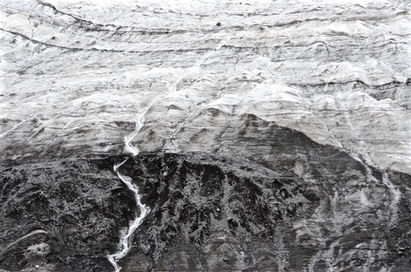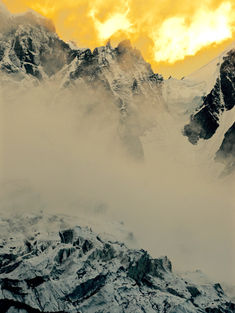
HOR'LAM
ROAD OF
PASHMINA
ROUTE OF
WIND &
WOOL
“Wind is the origin of life”
-Tibetan Saying
When first my hands touched a range of wools laid out by a man in Ladakh years ago I was urged to touch one tawny coloured example, which the man referred to as “cream from the mountains”. Soft, light, and finely spun, the wool oozed warmth and I was instructed to use the back of my hand, to run along the surface, not the fingertips. In as much as cream could have a ‘feel’, thiswas something utterly and immediately understood. It was divine and designed for warmth in the Himalayas...and it came from a particular goat which was still kept high on the 'Tangs' (grasslands).
Mountain people have long used and worn wools, and famously wrapped wools around the waist to keep the vital chakra areas heated. The source material for such warmth was entirely Himalayan. Yak wool, sheep wool, and one of the more coveted fabrics of mortals, pashmina, all came from creatures that lived in close contact with their tenders and away from the noise and sprays of man.
Combed off of pashmina goats from lands even higher than the one where I first made Pashmina’s acquaintance, the wool was brought down to those who could trade or buy it and then distribute it. It came from nomadic clans whose herds of goats and yak moved many times a year seeking out pastures from which to feed. Called ‘lèna’ by the locals of Ladakh, pashmina remains a luxury item and its journeys to reach the market capitals of course drew me in. Source regions were often simply referred to as 'gar' or 'camps', but some regions became famed for the quality of their wools. Karnak and Rupshu were names that drew buyers to markets.
As with so many of the routes in the land of snows (and melting glaciers) there were many strands leading to trading hubs from high within the Himalayas. But, there were still very clear pathways that were known and remembered, and in some cases that still functioned as they had in the past. They were strands linking the roving nomads with the market towns that ensured a further dispersal of the coveted fabric to the west and east. These routes too, ensured that small treats and luxuries from far were accessible to even the most remote of communities…though their version of ‘luxury’ might differ from others.
Michael Kleinwort would again join in with all of his candour and camaraderie in the mountains. We would journey by foot for a month tracking one of the main channels of the soft warm wool, into Tso Kar and Tso Moriri from the ancient Tibetan kingdom of Spiti. We would head west through Leh to valley that connected the Nubra Valley with the Leh valley, and finally we would visit the remarkable Karnak nomads, who have long been revered for their Pashmina, their weaving, and their will to continue a lifestyle that defies so much of the modern world.
So much about the trade routes' appeal is what is left of the actual routes. A remarkable resilience is necessary to remain relevant into the present tense. Pilgrimage routes, migration routes, and pathways of trade all continue to interweave with one another. Still now, much of the India Himalaya, Nepal and Tibet itself is still only accessed by hoof, foot, and a bit of grit. Many caravans famously disappeared in blizzards and one of the grand lessons of the mountains is that there are never any straight lines through them. So much of the eloquence of the the mountain tales continues to be from those who still travel them by foot, remembering the 'shortcuts' over passes, or the little shelters from the the cold and ferocious winds.
It was on this journey, that I would be introduced to two characters that would remain forever in my blood: the horseman of legend, Sadanand, known for wearing wooden socks and a pair of modified Crocs over snow passes high above 5000 meters, and my 'guru' Karma who would fuel and counsel many journeys - a man that still to this day remains one of my teachers in all things altitude and life.
Like with so much of journeying, one of the great narcotic joys is being or getting closer to that concept of autonomy. Having the vitals nearby and close, and realizing that those vitals are few. It is perhaps what has made the mountain people such compelling storytelling legends and so philosophical; they haven’t yet been able to leave Nature’s great teachings behind. Comforts haven't yet alienated or shielded them from Nature's wisdom, its brutality, or its restorative power.
In particular it was time with with the Karnak people in their wind-blown camps, and their abilities to maintain the interconnection with each other and their environments, which inspired.





































